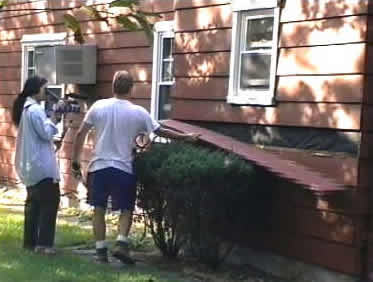 | |
| After interviewing Dr. Cesare Maltoni about his 1970s research on dioxin exposure from PVC, Helfand and Gold show some of the laboratory rats that contracted cancers from low-level exposure to dioxin. |
To substantiate the flagrant environmental injustices occurring for both workers and residents living in vinyl sided homes, most studies indicate that any benefits of PVC are outweighed by their risks. Helfand calls PVC “the Watergate of molecules,” since it is more dangerous than any other plastic. A single PVC fire can cause disease and death. But the danger doesn’t stop there. Dioxin is produced at both ends of the PVC life cycle, so PVC and its vinyl output is not easily recycled. PVC ends up in landfills causing more disease and death. According to Helfand, the damage caused by PVC is similar to what DES did to her. All evidence demonstrates that dioxin is an unwanted contaminant caused by PVC, a toxic waste that is not degraded by humans or the environment. If dioxin is getting in the atmosphere, it’s getting in the food chain and building up in our bodies, Helfand explains, highlighting the breadth of environmental injustices associated with use of PVC.
The environmental injustice associated with PVC production, use, and disposal extends to human rights issues when Attorney William (Billy) B. Baggett, Jr. reinforces Helfand’s claims. As a lawyer, he can legally film areas where exposed workers have been, but he is only allowed one plant visit. When he enters the factory, he uses five cameras on a handheld platform to get a 360-degree view, hoping to show where workers he is representing might have been exposed to polyvinyl chloride. To augment Baggett’s evidence, Helfand and her crew provide examples of workers afflicted with cancer and other diseases due to PVC exposure. One afflicted worker’s wife holds a hand-written note on a bill that proves the company’s culpability: “Exceeds short-term exposure. Do not include on wire to Houston,” the note explains, a message whited out on the versions Baggett receives from the company. This blatant omission provides proof and lays the groundwork for conspiracy allegations against all PVC manufacturers, with Baggett, the lawyer, leading the charge.
This omission serves as strong evidence of human rights violation, as criminal activity that puts people who work in or live near the factory or live in vinyl-sided homes at risk. The industry’s knowledge of the negative effects of PVC exposure is confirmed in the documents Baggett and his clients find, including internal industry documents from Venice, Italy to all parts of the United States warning about the dangers of PVC toxins. According to Blue Vinyl, the European Vinyl industry researched PVC repercussions in 1972 and discovered that low doses of vinyl chloride caused cancer in laboratory mice, even in amounts that were less than the legal levels to which workers were exposed. None of this was revealed to the public, however, because a secrecy agreement was signed in Europe, and American companies agreed to it.
 | |
| Billy Baggett gives the filmmakers a tour of the PVC industrial complex at night, emphasizing his mixed feelings about his reactions to the spectacular view its flames produce. |










